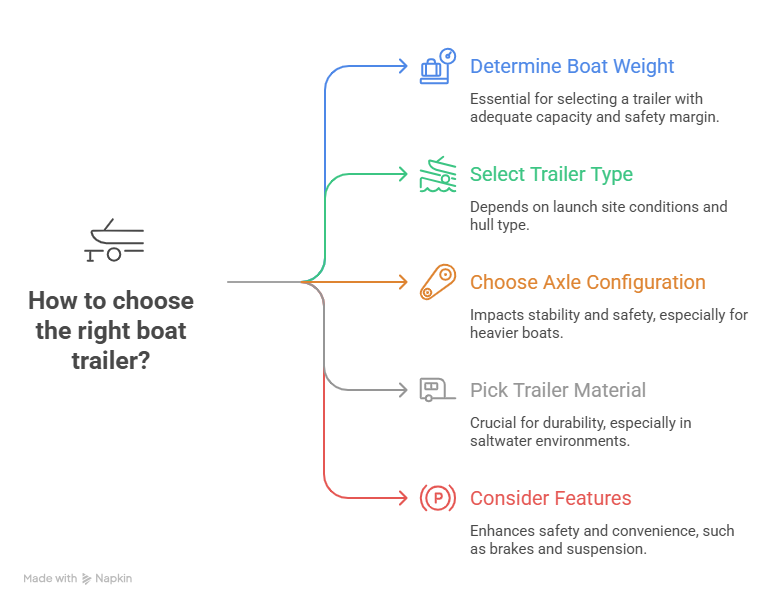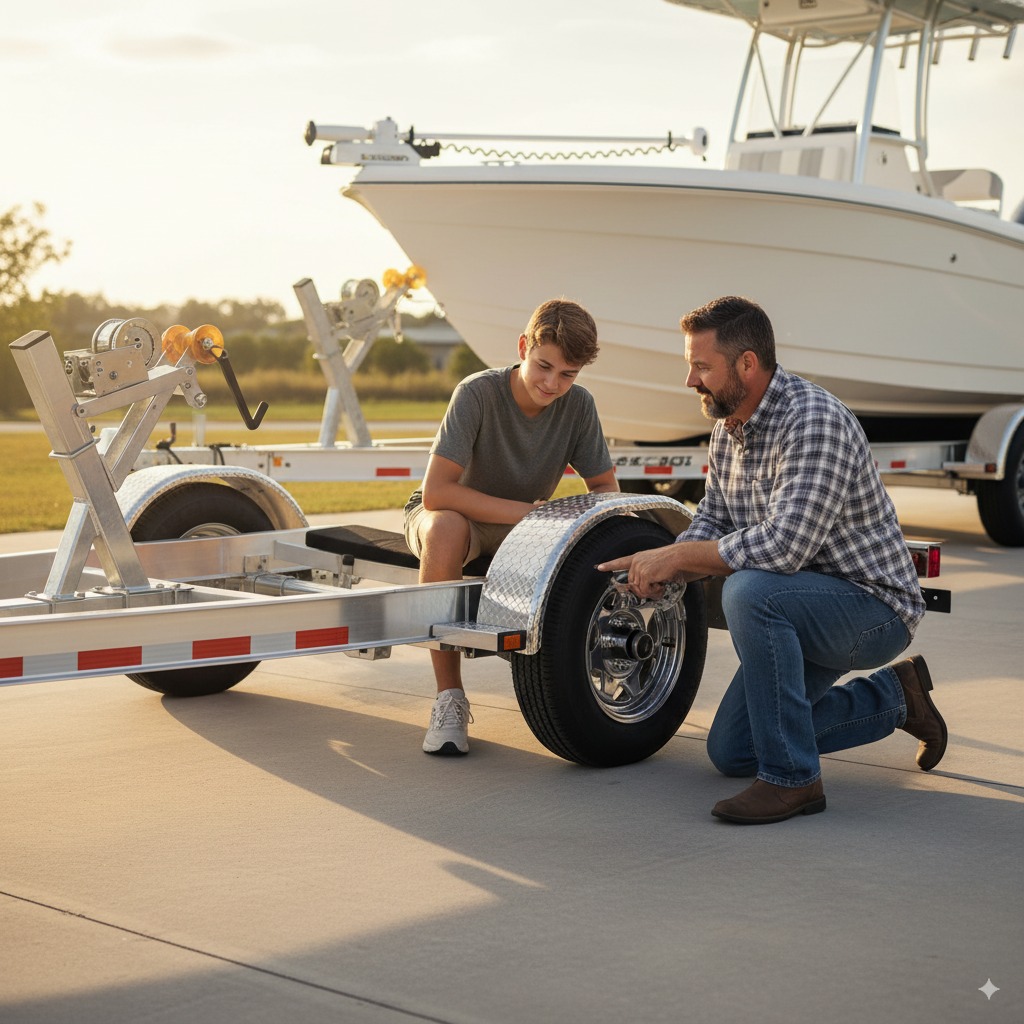I’ll never forget the first boat trailer I ever bought. It was for a 17-foot center console, and I thought I got a great deal on a used one. The first time I tried to launch at a shallow ramp near Fort Lauderdale, it was a total nightmare. The boat wouldn’t budge off the bunks. I spent an hour sweating in the Florida sun, holding up the line, and feeling like a total rookie. I learned a hard lesson that day: the right boat trailer isn’t an accessory; it’s a critical piece of gear that can make or break your day on the water.
Your boat is a huge investment, a source of incredible memories. Protecting it starts the moment it leaves the water. Getting the trailer wrong can lead to everything from frustrating launch days to serious damage or even a dangerous situation on the highway.
Navigating the world of boat trailers can feel overwhelming. There are endless options for weight capacities, materials, and axle setups. This guide is here to cut through the noise. I’m going to share what I’ve learned over 20 years of boating—the good, the bad, and the expensive mistakes—so you can make a smart choice. We’ll cover:
- How to match a trailer to your boat perfectly.
- The features that actually matter for safety and ease of use.
- Maintenance tips that will save you a fortune.
- How to avoid getting ripped off.
Let’s make sure your towing experience is as smooth as a glassy day on the water.
Table of Contents
It All Starts with Weight: The Golden Rule
Before you even think about trailer types or brands, you need to know your boat’s true weight. I’m not talking about the “dry weight” the manufacturer lists. I mean the fully loaded, ready-to-fish weight. That includes:
- The boat and engine.
- A full tank of fuel (gas weighs about 6 pounds per gallon).
- Water in any tanks.
- All your gear—coolers, tackle, safety equipment, everything.
Once you have that number, add a safety buffer of at least 15-20%. If your fully loaded setup weighs 4,000 lbs, you need a boat trailer with a capacity of at least 4,600 lbs. This isn’t just a suggestion; it’s a critical safety margin that reduces stress on everything from the tires to the frame.
Bunks vs. Rollers: It’s All About Where You Launch
This is one of the biggest debates, and the answer depends entirely on your local boat ramps.
| Trailer Type | Best For | My Take |
|---|---|---|
| Bunk Trailer | Deep water ramps; long-term storage | Offers the best hull support. The boat rests on long, carpeted boards, which is great for the hull. But you need to be able to submerge most of the trailer to float the boat off. If your ramps are steep and deep, this is the way to go. |
| Roller Trailer | Shallow or low-tide ramps | These make launching and retrieving incredibly easy. You can push the boat off with one hand. But the rollers can create pressure points on the hull if they’re not adjusted perfectly. They also require more maintenance. If you launch at challenging spots, a roller trailer is a lifesaver. |
For specialized hulls like pontoons or catamarans, you need a trailer designed specifically for that shape. Don’t try to make a standard V-hull boat trailer work; you’ll damage your boat.
Axles and Materials: The Backbone of Your Rig
How Many Axles?
- Single-Axle: Great for smaller, lighter boats. They are easier to maneuver by hand and have lower maintenance costs. The downside? If you have a blowout on the highway, you’re in for a very bad day.
- Tandem (Dual) Axle: A must-have for heavier boats (generally over 3,000-4,000 lbs). They are far more stable on the road and provide a huge safety net. A blowout on one tire is an inconvenience, not a catastrophe. They cost more and are a bit harder to park, but the peace of mind is worth it.
Aluminum vs. Steel: The Saltwater Battle
- Aluminum: If you boat in saltwater, this is the only real choice. An aluminum boat trailer is lightweight and highly resistant to rust. It will cost more upfront, but it will last infinitely longer in a salt environment.
- Galvanized Steel: Strong and more budget-friendly. They are a solid choice for freshwater use. You can use them in salt, but you absolutely must rinse them thoroughly with fresh water after every single use. Even then, they will eventually rust.

The Features That Really Matter
- Brakes: Don’t even think about skipping these on a heavy load. In most states, they are legally required for trailers over 3,000 lbs.
- Surge Brakes (Hydraulic): Simple and effective. They work automatically when your tow vehicle slows down.
- Electric Brakes: Offer more precise control but require a brake controller in your truck.
- Suspension:
- Leaf Springs: The old-school, tried-and-true option. They are tough and cheap to replace.
- Torsion Axles: Offer a much smoother ride and require less maintenance. They cost more, but the ride quality is noticeably better.
- Tongue Weight: This is the downward force on your hitch. It should be 10-15% of your total loaded trailer weight. Too little, and the trailer will sway dangerously. Too much, and it will overload your tow vehicle’s suspension. You can adjust this by moving the winch stand or the axles.
- Lights: Go for sealed, waterproof LED lights. They last longer and are far brighter than old-school incandescent bulbs. It’s a simple upgrade that makes a big difference in safety.
Pre-Trip Checklist: The 5-Minute Drill That Can Save Your Life
Before you pull out of the driveway, every single time, do this quick check. It has saved me from disaster more than once.
- Tires: Check the pressure on all tires, including the spare. Look for cracks or bulges.
- Hitch: Make sure the coupler is securely latched and pinned.
- Chains: Crisscross the safety chains and ensure they are securely attached.
- Lights: Plug in the wiring and test your running lights, brake lights, and turn signals.
- Tie-Downs: Your boat should be secured with a winch strap at the bow and at least two transom straps at the stern.
FAQ: Questions I Get Asked All the Time
1. How do I know my truck can tow a certain boat trailer?
Check your vehicle’s owner’s manual for its maximum towing capacity and tongue weight limit. Never exceed these numbers. It’s not just about power; it’s about braking and stability.
2. What’s the most overlooked maintenance item?
Wheel bearings. They live a hard life, constantly being dunked in water. They need to be repacked with grease annually. If they fail on the highway, your wheel can come right off.
3. Is buying a used boat trailer a good idea?
It can be, but you have to be careful. Inspect the frame for rust or cracks, check the tire date codes (anything over 5-6 years old is suspect), and assume you’ll need to replace the bearings and possibly the brakes.
4. What are guide-ons?
They are vertical posts you add to the back of your trailer that help you center the boat during retrieval, especially in wind or current. They are a fantastic upgrade for any boat trailer.
5. Why is my trailer swaying on the highway?
This is almost always caused by not enough tongue weight. Your load is too far back. Try moving the boat slightly forward on the trailer or adjusting the axle position.
Final Thoughts: Invest in Peace of Mind
A boat trailer is a critical part of your boating life. Choosing the right one is an investment in safety, convenience, and the protection of your boat. Don’t rush the decision. Do your homework, overestimate your needs, and don’t be afraid to spend a little extra for quality features like good brakes, LED lights, and the right material for your environment.
Your future self will thank you every time you pull up to the ramp with a perfectly matched, well-maintained boat trailer, ready for another great day on the water.
Author Bio
I’m Alex, a 15-year boater and DIY mechanic based in South Florida. I’ve owned everything from small skiffs to offshore center consoles, and I’ve learned—often the hard way—what makes a good boat trailer hold up in the harsh saltwater environment. I’m passionate about helping other boaters make smart, informed decisions to keep their adventures safe and stress-free.


Leave a Reply